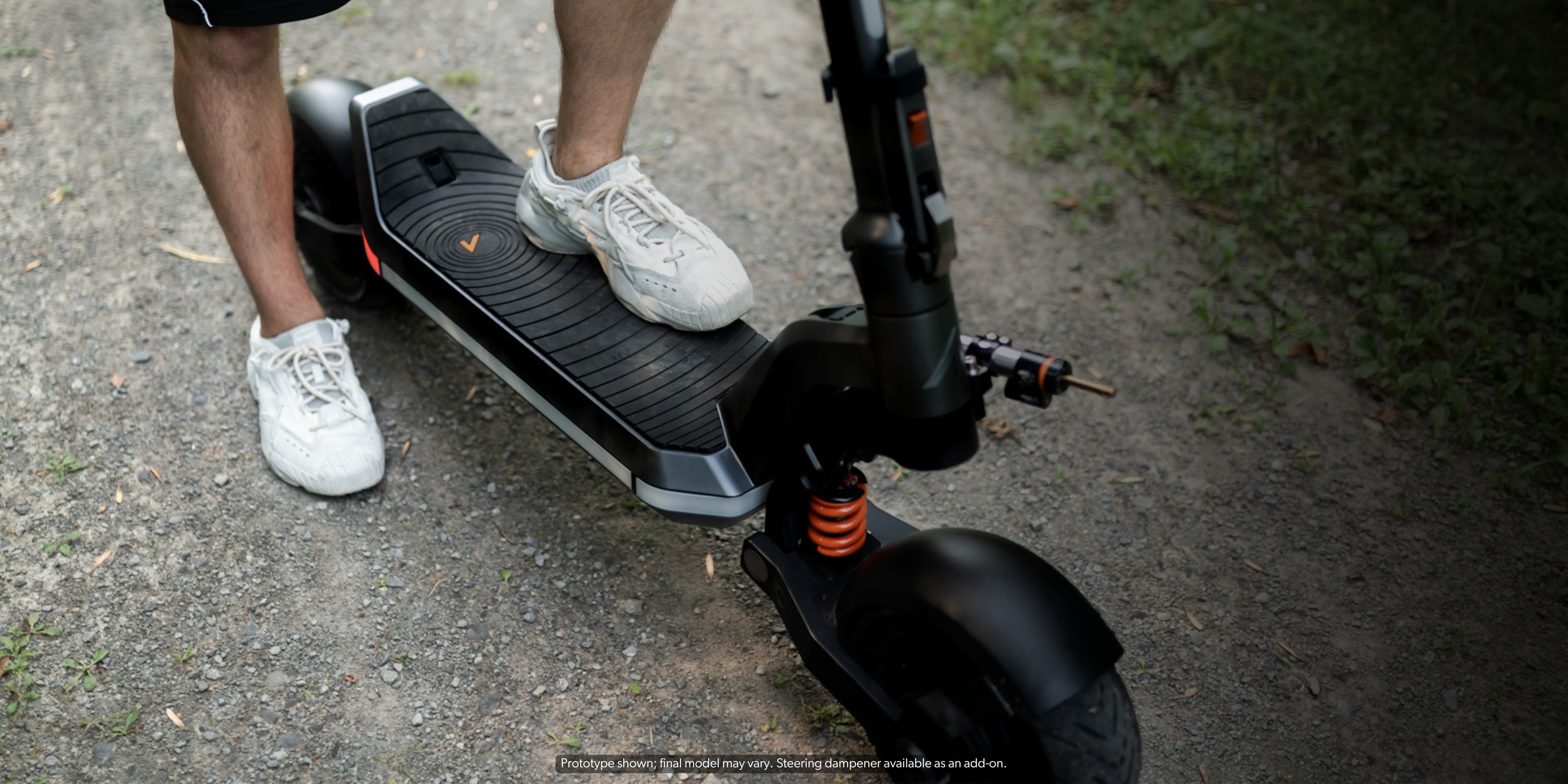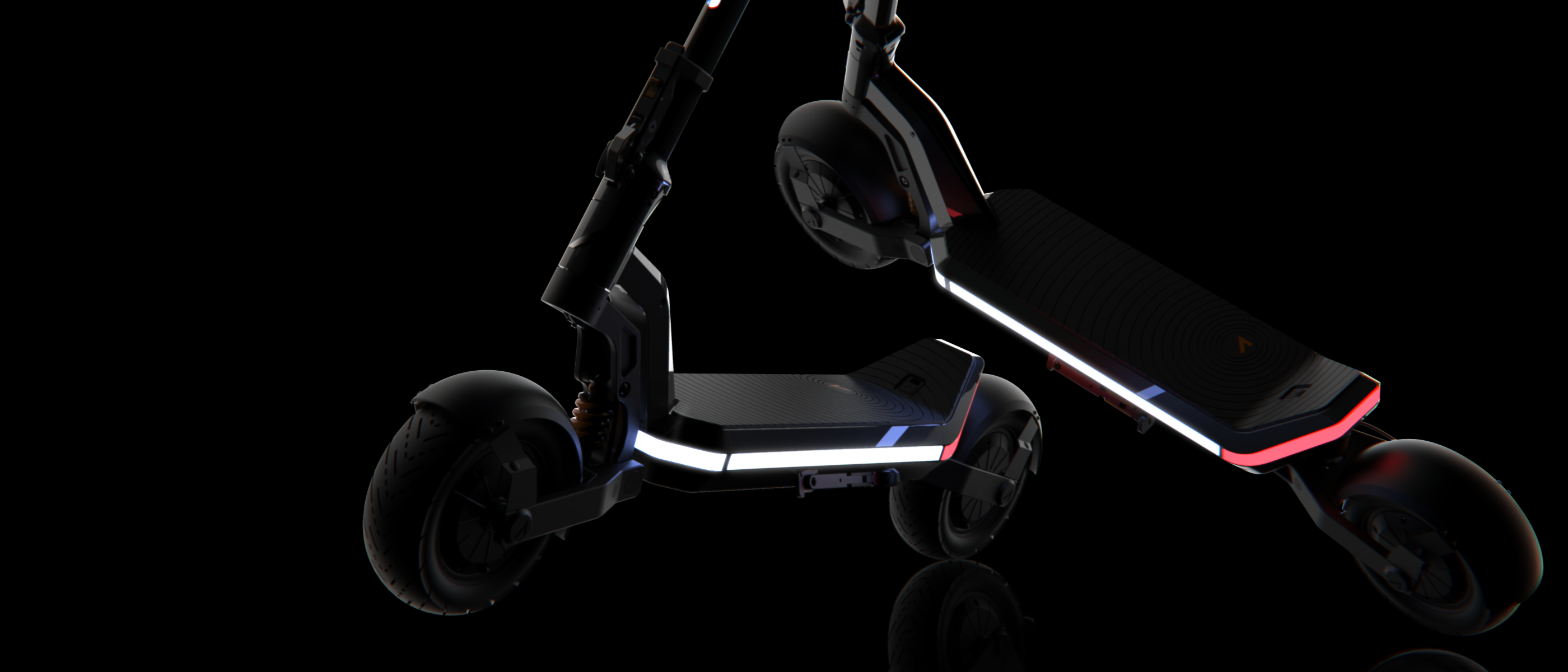Did you know that electric scooters have actually been around for a long time? Feels like a joke, right? But over 20 years ago the Currie Flyer electric scooter came out for sale; featuring 12” air filled tires, a top speed of 24 km/h and a range of up to 19 km (or so it claimed). It used two, 12 volt lead-acid gel cells of 10AH in series, for 24v yielding a maximum of 240Wh of power.
It should be noted that this battery chemistry was not ideal for deep cycle discharging and charging, so charges should have been kept close to maximum, but running the battery down to its claimed mileage range was to be avoided to maintain favorable battery life. This scooter had no lighting, and poor suspension and brakes. The motor was driving a chain to a large gear on the rear wheel, compensating for relatively low torque. It’s clear scooters have come a long way since then.
Figure 1: Currie Flyer electric scooter c2003
The “modern” electric scooter (the scooter as we know it today), made its appearance in late 2016, with the widespread adoption of the Xiaomi M365 in both retail and rental markets.
The two key factors that distinguish the modern electric scooter from earlier designs are the new Li-ion (Lithium ion) battery technology and the high torque direct drive motors.
Why Do Electric Scooters Use Li-Ion Batteries?
Li-ion batteries are a completely different type of battery than older cell types. They not only have an increased cell voltage and energy density (more power for a given size), but they also weigh much less for any given amount of capacity than lead acid cells.
Figure 2 Lithium Ion battery technology and battery pack used in M365 scooter made up of many 3.6v individual cells
High Torque Electric Motors in Modern Scooters
They allow the integration of the motor into the wheel hub and do not require any gear reduction, by chain or planetary gearing. (Hub motors in ebikes generally require planetary gearing due to the much larger wheel diameter.)
Figure 3 M365 direct drive motor
The use of high torque hub motors and li-Ion batteries allowed the M365 to duplicate the range and speed of the Currie Flier pictured above, in a conveniently much smaller package that weighed less than half as much; 27 pounds for the M365, versus almost 60 pounds for the Flier.
Figure 4 Bird rental version of the Xiaomi M365
It was not long after these basic scooters started showing up that rental companies and owners/riders wanted more. The manufacturers responded. Often with faster machines, adding features including more power, more speed, suspension, lighting, off road capability, increased durability, and every combination therein.
Unlike internal combustion machines (including automobiles, motorcycles, and gasoline fueled mopeds and scooters), when an electric scooter runs low on its source of energy, “re-fueling” takes hours, not seconds, or minutes. The same holds true for purely electric automobiles. This has led to a new source of urban stress commonly referred to as “range anxiety.” As with automobiles, the most straightforward way to combat range anxiety is to increase the battery capacity. Hence, the birth of the long-range scooter.
In its Most Basic Form, What is a Long-Range Scooter?
It’s a scooter with a battery capacity that will allow it to travel a fairly long distance at its nominal speed and performance level without needing to be recharged.
There is no universal definition of the usable distance for a long-range scooter. For the purposes of this blog, we’ll consider anything usable at nominal speed and performance for a distance exceeding 30 miles (or 50 km) to be a long-range electric scooter.
How Far Will an Electric Scooter Go On a Full Charge?
There are some serious and significant caveats to this, beginning with what’s considered to be nominal speed and performance. With any electric vehicle – and scooters are no exception to this – range can be significantly impacted by the demands made upon it during that journey. It’s important to understand these factors prior to reading stated range figures for an electric scooter.
Speed and wind conditions:
The power required to cut through the wind is most often greater than the power required to overcome rolling resistance of the wheels. Particularly on properly inflated tires on a well paved surface. Heading into the wind will impact range near equally as traveling at the wind speed plus the ground speed in still air.
Rider weight:
Unlike an automobile, a rider’s weight is a significant part of the gross weight of an electric scooter. Most scooters are rated for riders of roughly 160 pounds or so. Some are tested at even lower rider weights. Consider the difference between a 150 pound driver and a 250 pound rider on an Apollo City.
Apollo City’s net weight is 65 pounds. With the 150 pound rider, the gross weight is 215 pounds. With a 250 pound rider the gross weight is 315 pounds. The rider weight difference is 1.5 times the net weight of the scooter itself.
Now, consider the Tesla Cybertruck. The net vehicle weight is roughly 6,500 pounds, so a 100 pound increase in a driver’s weight amounts to 0.015 times the net vehicle weight. Hence diver weight is not going to impact the Cybertuck range, whereas the Apollo City will be impacted. This doesn’t even take into account the increased size, and hence aerodynamic impact of a larger rider on a scooter versus a car or truck where the occupants are inside an aerodynamic envelope.
Terrain:
Is the route hilly, or flat? Is the surface well-paved or a trail with loose gravel or dirt? Hills take much more energy to climb over any distance than level ground. The downhills are generally not going to provide as much energy savings as the up-hills require in extra power.
Acceleration and deceleration:
Electric scooters are similar to other powered vehicles in that rapid acceleration can increase the energy use. Electronic scooters also use a bit more energy starting from a dead stop than when they are moving a bit. Therefore, not using “zero start” and pushing off prior to using the throttle will yield a bit more range. Some scooters also have regenerative braking, which can return some energy that would normally be released as heat (and also brake wear) into the battery packs, increasing range. Apollo scooters are on the leading edge of very usable progressive regenerative braking.
Rolling resistance:
Resistance of the wheel motors and bearings on the machine, and rolling resistance of the tires can impact range. Higher pressure, thinner road tires will have less rolling resistance than wider, lower pressure, and off-road tires.
So - do scooters actually go the max range mentioned by manufacturers? Well, they can but consider you will only achieve them under “best case scenarios.” If you weigh more than 165 pounds and travel at speeds over 15 mph (25 kph), or travel on less than level smooth pavement, consider the strong possibility that you will not achieve the range estimates printed on the box your scooter came in.
What Are the Reasons To Buy a Long Range Electric Scooter
When it comes to commuting or weekend adventures, range is everything. A long-range scooter opens up more freedom, fewer charging stops, and greater peace of mind. A long-range scooter gives you the power to ride farther, explore more, and charge less.
-
If one has a long commute, or limited access to charging, a longer range scooter may be a necessity
-
They allow longer rides of greater distances and duration for recreation, transportation, and travel
-
In cases where one does not intend to exceed the range of the scooter, extra range allows higher speeds to be run on the route
-
Multiple commuting days or trips can be accomplished without charging
-
Batteries have a limited number of use/recharge cycles. In addition to long range electric scooters allowing fewer charging cycles over a given mileage, deep cycles of full charging and discharging further limit battery life. Ideally, electronic scooter batteries are operated between 80% charge on the high end and 20% charge on the low end. Longer range scooters allow more distance to be covered while keeping the battery packs mostly within this 80/20% charge range. A replacement battery pack can cost nearly half as much as the initial cost of the scooter. Battery preservation, if the scooter is used often represents significant cost savings. The battery capacity may well double the usable life of the battery pack, or more, since a degraded high-capacity battery pack may still be useful when a lower initial capacity pack will not offer enough remaining range to be usable and will require replacement.
Should I Purchase a Long Range Electric Scooter?
For a given performance level of electric scooter (speed and power), higher capacity battery packs that will give longer range, increase the weight and size of the electric scooter. Most modern scooters use battery packs made up of a set of individual cells. These are of similar size and capacity per cell.
Long range electric scooters gain their extra range by using battery packs that have more cells in them. The space to house these cells generally must be increased. So, you get not only the extra weight of the bater pack but also the weight of the larger housing. However, the increased housing size allows a larger deck with more ability for the rider to maintain a comfortable riding position over long rides. Therefore, the increased size and weight may be offset by the more comfortable riding experience in high performance, long-range scooters such as the Apollo Phantom Stellar.
The cost of a battery pack can be almost half the cost of an electric scooter. Increasing the capacity of the battery pack will increase the manufacturing cost of the electric scooter with this cost reflected in the purchase price.
So, Should You Get a Long Range Electric Scooter?
It is a matter of personal priorities. If compact size and low weight are important or if cost is a limiting factor, then likely no. For many users, more freedom from range anxiety and the ability to exceed low to modest speed cruising will make longer range scooters attractive.
A final thought:
It should be noted that Apollo has kept statistics on how far users typically take their scooters on recorded runs. It’s much shorter than one would expect. Riders seem to be taking relatively short rides at low average speeds. The highest average speeds on the performance model is 24 km/h and the longest trips are roughly 6 km (one way, 12km round trip). (That said, some riders are clocking rides of over 32 km.)
The lesson is that even if one thinks they need a long range scooter, the data shows you should consider if you will really be making those long range trips.






